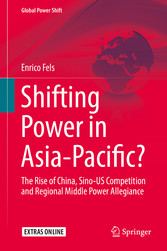Suchen und Finden
Service
Shifting Power in Asia-Pacific? - The Rise of China, Sino-US Competition and Regional Middle Power Allegiance
Enrico Fels
Verlag Springer-Verlag, 2016
ISBN 9783319456898 , 768 Seiten
Format PDF, OL
Kopierschutz Wasserzeichen
Geräte
Acknowledgements
6
Contents
9
List of Abbreviations
13
Chapter 1: Opening the Floor: The Rivalry Between Eagle and Dragon in Asia-Pacific
18
1.1 Literature Overview: The Attested Struggle Between Giants
31
1.2 Tackling the Academic Void: Research Puzzle and Research Questions
73
1.3 Some Opening Words on Methodology and Research Design
75
References
90
Chapter 2: Theoretical Framework: Realism as a Lens for Analysis
102
2.1 Classical Realism
108
2.2 Structural Realism
113
2.3 The Core of Realist Theories
119
2.4 The Balance-of-Power Theory
126
2.5 International Cooperation in a Realist World
138
References
164
Chapter 3: Power in International Relations
170
3.1 Aggregate Understandings of Power
175
3.2 Relational Understandings of Power
180
3.3 Structural Understandings of Power
188
3.4 The Challenge of Measuring Power
196
3.5 The Continuing Relevance of Capabilities
200
References
205
Chapter 4: Towards a Middle Power Theory in International Relations
211
4.1 Great Powers
216
4.2 Middle Powers
223
4.3 The Role of Middle Powers in Understanding Shifts in Relational Power
230
References
236
Chapter 5: Taking Stock of Asia-Pacific´s Tangible Power Changes: Measuring Aggregate Power
240
5.1 An Index of Aggregate Power: The Cline Formula
242
5.1.1 Critical Mass
245
5.1.2 Economic Capabilities
246
5.1.3 Military Capabilities
249
5.1.4 Strategic Purpose and National Will
253
5.2 Reconceptualising and Refining the Cline Formula: Modelling a New Composite Indicator on Aggregate Power (CIAP)
255
5.2.1 Standardisation
259
5.2.2 Weighting and Grouping
260
5.2.3 Aggregation and Sensitivity Testing
263
5.3 Adding Empirical Flesh to Theoretical Bones: Calculating the CIAP
266
5.3.1 Critical Mass
266
5.3.2 Economic Capabilities
269
5.3.2.1 Gross National Product
269
5.3.2.2 Domestic Energy Supply and External Energy Dependence
278
5.3.2.3 Critical Nonfuel Minerals
282
5.3.2.4 Industrial Strength
290
5.3.2.5 Food Production and Dependency
298
5.3.2.6 Trade
302
5.3.3 Military Capabilities
310
5.3.4 Strategic Purpose and National Will
325
5.4 Assembling the CIAP
334
5.5 Summary and Evaluation of Findings
342
References
346
Chapter 6: Determining the (Almost) Intangible: Measuring Relational Power
356
6.1 Defining Measures for Comparative Case Studies in Mixed-Method Research on Relational Power
359
6.2 Neither Small Nor Great: Identifying Middle Powers in Asia-Pacific
368
References
376
Chapter 7: Australia: Trading with the Dragon, But Flying with the Eagle
380
7.1 Australia as a Middle Power
380
7.1.1 Economic Development
380
7.1.2 Foreign Policy
381
7.1.3 Security Profile
382
7.2 Australia´s Relations with the United States
384
7.3 Australia´s Relations with China
400
7.4 Analysis: Shifting Allegiance?
428
References
442
Chapter 8: Pakistan: `Iron Brother´ to Beijing, Reluctant Partner for Washington
452
8.1 Pakistan as a Middle Power
452
8.1.1 Economic Development
452
8.1.2 Foreign Policy
457
8.1.3 Security Profile
459
8.2 Pakistan´s Relations with the United States
462
8.3 Pakistan´s Relations with China
484
8.4 Analysis: Shifting Allegiance?
503
References
513
Chapter 9: Japan: Warm Ties to Washington, `Cold Politics´ with Beijing
521
9.1 Japan as a Middle Power
521
9.1.1 Economic Development
523
9.1.2 Foreign Policy
527
9.1.3 Security Profile
528
9.2 Japan´s Relations with the United States
530
9.3 Japan´s Relations with China
547
9.4 Analysis: Shifting Allegiance?
561
References
571
Chapter 10: The Republic of Korea: No Longer a Small `Shrimp Among Whales´
581
10.1 The ROK as a Middle Power
581
10.1.1 Economic Development
582
10.1.2 Foreign Policy
584
10.1.3 Security Profile
587
10.2 The ROK´s Relations with the United States
589
10.3 The ROK´s Relations with China
612
10.4 Analysis: Shifting Allegiance?
630
References
642
Chapter 11: Thailand: Bending with the Wind Again?
650
11.1 Thailand as a Middle Power
650
11.1.1 Economic Development
650
11.1.2 Foreign Policy
652
11.1.3 Security Profile
655
11.2 Thailand´s Relations with the United States
657
11.3 Thailand´s Relations with China
674
11.4 Analysis-Shifting Allegiance?
686
References
702
Chapter 12: Indonesia: Rowing Between Two Reefs Once More
709
12.1 Indonesia as a Middle Power
709
12.1.1 Economic Development
710
12.1.2 Foreign Policy
712
12.1.3 Security Profile
713
12.2 Indonesia´s Relations with the United States
716
12.3 Indonesia´s Relations with China
726
12.4 Analysis: Shifting Allegiance?
736
References
752
Chapter 13: Conclusion: Does `Rising´ in Power Equate to `Shifting´ of Power?
760
References
778
Service
Shop



